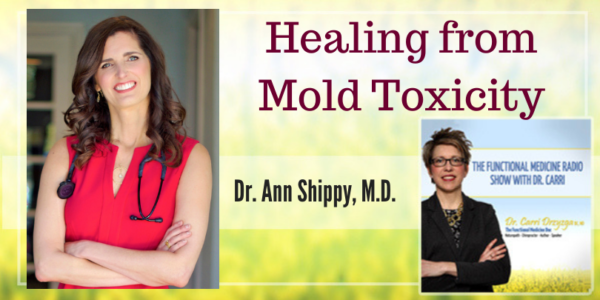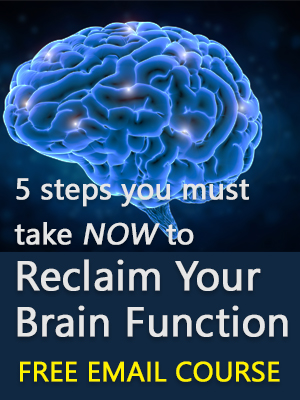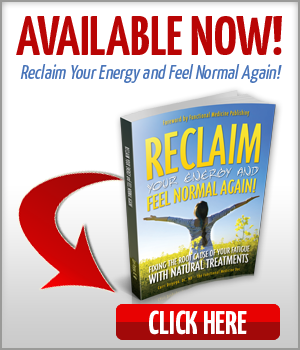Podcast: Play in new window | Download
Subscribe: Apple Podcasts | Android | RSS
In this episode of The Functional Medicine Radio Show, Dr. Carri’s special guest Dr Ann Shippy explains the symptoms of mold toxicity and mold exposure.
Dr. Ann Shippy, MD, is on a mission to help create extraordinary wellness by using cutting-edge science, testing, and the latest genetic research to find and treat root causes—and not just the symptoms—of illness. As a former IBM engineer, Dr. Shippy became frustrated that traditional medicine couldn’t find answers to her own health ailments, so she left a decade in engineering to adapt her skill set to the world of medicine.
She is board certified in internal medicine and certified in functional medicine. She is on a tireless mission to help create a world of wellness … “because every life matters”. She is the author of two books, Shippy Paleo Essentials and Mold Toxicity Workbook: Assess Your Environment & Create a Recovery Plan.
Main Questions Asked about Mold Toxicity:
- Why is mold exposure dangerous?
- What are the symptoms of mold exposure and mold toxicity?
- How fast do these symptoms occur? What about susceptibility?
- What is the difference between a mold allergy and mold toxicity?
- Where are some of the common places you might find mold?
- If somebody thinks they might have mold, what’s the best way to remediate that?
- What about at-home testing?
Key Points made by about Mold Toxicity by Ann Shippy:
- Mold, in its growth process, makes chemicals called mycotoxins or mVOCs (microbial Volatile Organic Compounds). There are hundreds of types of mold and thousands of chemicals being made.
- The mycotoxins, when we study them, can cause cancer, can suppress the immune system, can flare up autoimmunity, can directly damage genes; because there are so many chemicals, they have a lot of different effects on the body.
- You need to remember, when you’re handling the sandbags or pulling up old moldy carpet, is that some of these chemicals are the types of things binge used for biological warfare. Some are really significant carcinogens. We need to be handling these with caution – a Hazmat suit is not going too far.
- Just like any other environmental toxin, you won’t really have symptoms until your barrel fills up. Our bodies are constantly exposed to environmental toxins, but until you get to the point where the toxins are building up and interfering with the biochemistry and physiology, you’ll usually feel fine.
- What I see a lot with families is that each person has their own weak link where the toxicity has the biggest impact. Furthermore, this can occur in different timeframes, where one member of the household is suffering while the rest of the household feels “normal”. It’s hard for them to understand.
- When I hear symptoms that are really suspicious for mold toxicity – e.g., brain fog, OCD, anxiety, insomnia, hair loss, skin rashes, new onset asthma or worsening allergies – I ask myself “do I try these other things, that are less upsetting to their lifestyle, to get them better, or do I go straight to the issue of an environmental toxin like mold”?
- I think it’s really important to be proactive – if you had a water leak in your house and it wasn’t dried up within 24-48 hours, it makes sense to get an expert to come in and see if there is hidden mold, or to do your own testing.
- It’s necessary to be clear on the difference between a mold allergy and mold toxicity. The former is an allergy to the spore, the organism itself which unless you have severe asthma is not life threatening. The actual toxins themselves, however, is like getting poisoned, even a very small amount can make people very sick.
- Also note, that lack of an odour is not an indication that you don’t have mold.
- Mold toxicity is a big factor for cognitive decline, many patients with cognitive decline have some mold exposure in their history.
- Mold can result from, be hidden in simple things – the carpet you shampooed that didn’t dry properly, plumbing leaks (even pinhole leaks in dishwashers and ice makers), improperly sealed showers, flashing around chimneys and windows, air conditioning systems – there may not be enough water to be visible but there’s enough water to feed a mold colony.
- That 24-48 hours to clean up and dry up water is key.
- One of the clues for mold toxicity is when patients tell you they feel better at home than at the office; or feel better on vacation and worse when they get back. Mold is not always the case, but it is a red flag.
- If you think you have mold, you want to approach it very carefully. Professionals may be the way to go – someone who is very careful. You want to protect what you can by wrapping it in plastic; then you need to build plastic walls around the area to be remediated and use air scrubbers so that the air is cleaned.
- Keep in mind that some of these chemicals released are carcinogens, and/or used for biological warfare.
- There are at home tests for mold; the two I like are RealTime Labs and BlackMoldScan.com. You collect as much dust as you can from the area and send it in and they’ll analyze it for the mycotoxins and and DNA. Neither one will get 100% of the molds but it gives us a good starting point.
- You really want to get the mold eliminated. There’s some stuff you can do to alleviate symptoms while living in the mold but why not eliminate the cause.
- Then you need to detoxify the body, and do the rebuilding of the mitochondria, cell membranes, and organ systems, , that have been affected.
- The key thing I want people to know is that you can heal and get better.
Resources Mentioned for Mold Toxicity:
Book – Shippy Paleo Essentials
Book – Mold Toxicity Workbook: Assess Your Environment & Create a Recovery Plan
Book – Reclaim Your Energy and Feel Normal Again
Thank you for listening! If you enjoyed this podcast, please subscribe and leave a 5 star rating and review on iTunes!




